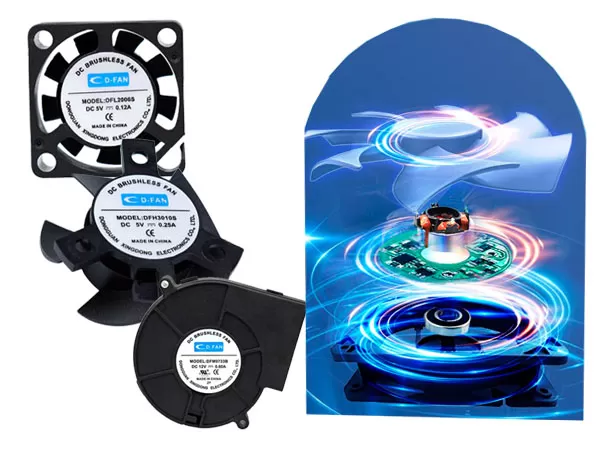Axial fans and DC blower fans are our mainly cooling fans. Our cooling fans are widely used in home appliances, automobiles, security, communications, medical, industrial control, electric power, printing, military, welding machines, instruments, computers, power supplies and other fields. Following are the main differences between axial fan and DC blower fan:

First, the working principle
Axial fan
Axial fans work by creating an axial thrust on the air through the blades, causing the air to flow in a direction parallel to the fan shaft. When the fan blades rotate, the special shape of the blades pushes the air forward, creating a continuous airflow. The direction of this airflow is basically the same as the direction of the fan shaft, just like the table fan we use every day, the wind blowing out is blowing in a straight line along the direction of the fan head.
DC blowers
DC blowers rely on a DC motor to drive the impeller to rotate. According to the principle of electromagnetic induction, when the current passes through the armature winding, the electromagnetic torque is generated under the action of the magnetic field, which drives the impeller to rotate at high speed. The rotation of the impeller causes the air to be drawn in and expelled, creating an airflow. Unlike axial fans, DC blowers have an impeller design and way of working that focuses more on generating higher pressures in a smaller space.
Second, structural characteristics
Axial fan
Blade shape: The blades of an axial fan are usually long and narrow in shape, similar to the wings of an airplane. This shape design helps to push the air along the axial direction more efficiently during rotation.
Overall structure: The structure of the axial fan is relatively simple, mainly composed of fan blades, motors, shells and other parts. The fan blades are mounted directly on the motor shaft, and the motor drives the fan blades to rotate to generate airflow.
DC blowers
Impeller design: DC blowers typically have smaller impellers and shorter, thicker blades, and more complex impeller shapes, which may be centrifugal or mixed-flow designs. This design allows the DC blower to generate high pressures during operation.
Motor-to-impeller connection: In DC blowers, the DC motor is connected to the impeller in a more compact way to ensure efficient energy transfer.
3. Performance characteristics
Air axial fans
Axial fans are typically capable of producing large airflows. This is because the blades are designed and worked in such a way that air can pass through the fan quickly, which is suitable for occasions that require large-area ventilation or heat dissipation, such as large computer rooms, ventilation ducts, etc.
DC blowers have comparatively smaller air volumes. Since its primary design goal is to generate higher pressures, the airflow may not be as large as an axial fan for the same size and power.
Wind pressure
The air pressure of an axial fan is comparatively smaller. It is suitable for working in systems with low air duct resistance, such as air circulation in open spaces.
DC blowers are capable of generating high air pressure. This makes it effective in pushing the air in some situations where the air duct resistance is large, such as complex heat dissipation systems, ventilation ducts with more bends or resistance components such as filters.
Speed regulation performance
The speed regulation performance of axial fans is average. While the rotational speed can be adjusted by changing the input voltage of the motor or by using inverter technology, the adjustment range and accuracy may be limited.
The speed regulation performance of the DC blower is very good. Due to its use of DC motors, the speed can be precisely adjusted by precisely controlling the input DC voltage or current, so as to achieve flexible control of air volume and pressure.
Fourth, the field of application
Axial fan
Home appliances: In home appliances such as air conditioners and air purifiers, axial fans are used to circulate and purify indoor air.
Industrial ventilation: In large industrial places such as factory workshops and warehouses, axial fans are used for ventilation, removing dirty air and keeping indoor air fresh.
DC blowers
Heat dissipation of electronic devices: In electronic devices such as computers and servers, DC blowers can effectively dissipate the heat inside the equipment to ensure that the electronic components work at the right temperature.
Automotive: DC blower fans are also used in the ventilation and air conditioning systems of automobiles to provide fresh air circulation in the vehicle and regulate the temperature and air quality in the vehicle.


 +86-13528507673
+86-13528507673
 E-mail
E-mail
